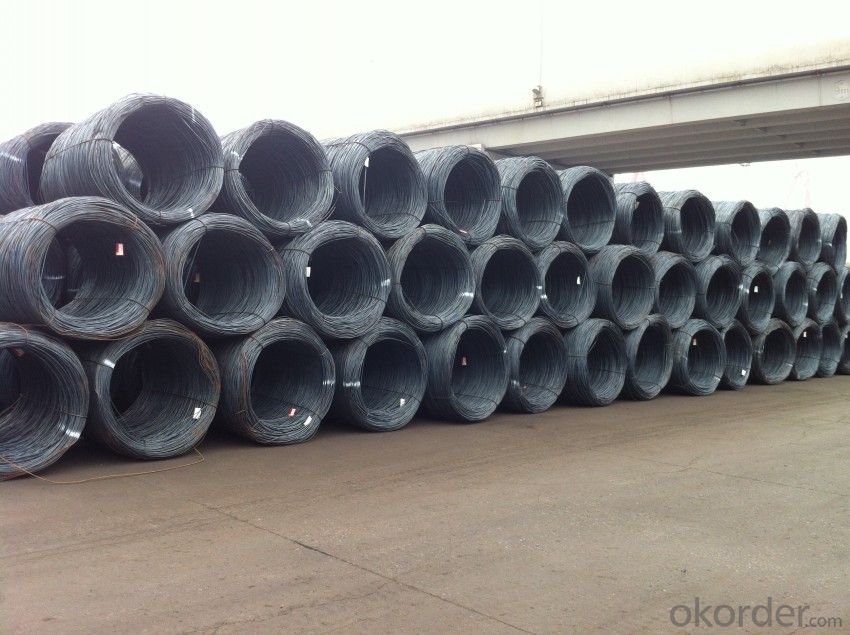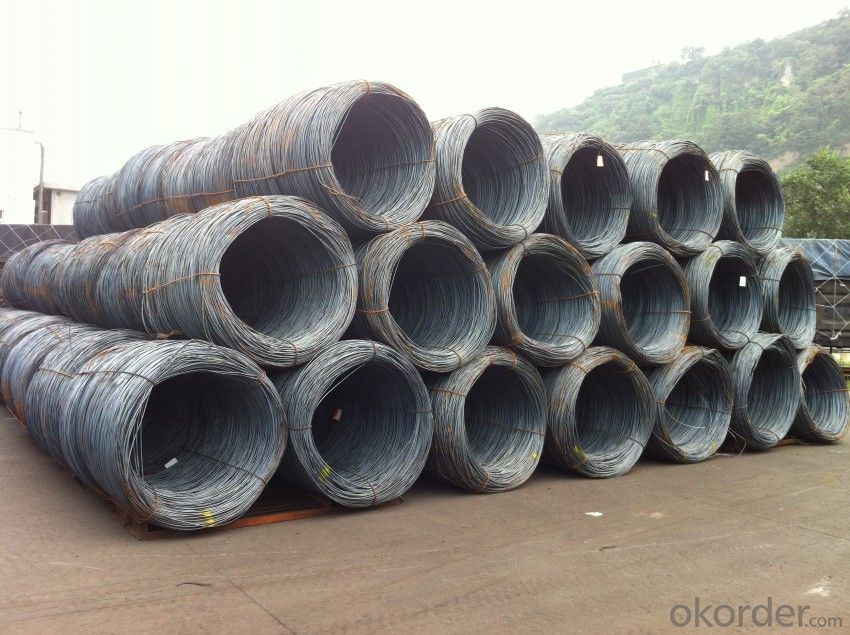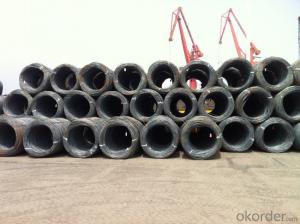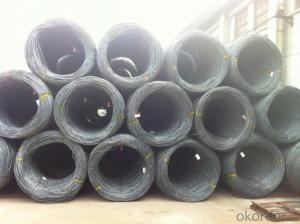Hot Rolled Wire Rods with Material Grade SAE 1008
- Loading Port:
- Tianjin
- Payment Terms:
- TT OR LC
- Min Order Qty:
- 25 m.t.
- Supply Capability:
- 10000 m.t./month
OKorder Service Pledge
OKorder Financial Service
You Might Also Like
Product Description:
OKorder is offering Carbon Steel Wire Rod at great prices with worldwide shipping. Our supplier is a world-class manufacturer of steel, with our products utilized the world over. OKorder annually supplies products to European, North American and Asian markets. We provide quotations within 24 hours of receiving an inquiry and guarantee competitive prices.
Product Applications:
Carbon Steel Wire Rod are ideal for structural applications and are widely used in the construction of buildings and bridges, and the manufacturing, petrochemical, and transportation industries.After hot-rolled the products shaped into coil and delivery as finished product, including round, square, rectangular, hexagonal and so on. Since most of the products are round, it is generally called wire rod. Carbon steel wire rod is widely used in construction and manufacturing. Carbon steel wire rod is mainly used for reinforcement of reinforced concrete and welded structure or reprocessed (roberts , nail, etc.) materials, especially used to produce wire drawing, welding electrode, nails, spring, electronic, precise machinery parts and so on.
Product Advantages:
OKorder's Carbon Steel Wire Rod are durable, strong, and resist corrosion.
Main Product Features:
· Premium quality
· Prompt delivery & seaworthy packing (30 days after receiving deposit)
· Corrosion resistance
· Can be recycled and reused
· Mill test certification
· Professional Service
· Competitive pricing
Product Specifications:
Chemical Composition:
Please kindly find our chemistry of our material based on SAE1006/SAE1008 as below for your information
Grade | Chemical Composition (%) | |||||
C | Mn | S | P | Si | B | |
SAE1006B | 0.03~O.07 | 0.32max | 0.045max | 0.040max | 0.30max | 0.0008min |
Mechanical properties | ||||||
Yield strength(N/mm2) | Tensile strength(N/mm2) | Elongation (%) | ||||
250-280 | 350-380 | ≥32 | ||||
Grade | Chemical Composition (%) | |||||
C | Mn | S | P | Si | B | |
SAE1008B | 0.10max | 0.3~0.50 | 0.050max | 0.040 max | 0.15max | 0.0008 min |
Mechanical properties | ||||||
Yield strength(N/mm2) | Tensile strength(N/mm2) | Elongation (%) | ||||
≥195 | 315-430 | ≥30 | ||||
FAQ:
Q1: Why buy Materials & Equipment from OKorder.com?
A1: All products offered byOKorder.com are carefully selected from China's most reliable manufacturing enterprises. Through its ISO certifications, OKorder.com adheres to the highest standards and a commitment to supply chain safety and customer satisfaction.
Q2: How do we guarantee the quality of our products?
A2: We have established an advanced quality management system which conducts strict quality tests at every step, from raw materials to the final product. At the same time, we provide extensive follow-up service assurances as required.
Q3: How soon can we receive the product after purchase?
A3: Within three days of placing an order, we will begin production. The specific shipping date is dependent upon international and government factors, but is typically 7 to 10 workdays.
Image


- Q:How is steel wire rod used in the manufacturing of reinforcing bars?
- Steel wire rod is used in the manufacturing of reinforcing bars by being stretched and formed into the desired diameter and shape. It is then commonly used as the core material within reinforced concrete structures to provide strength and stability, enhancing the load-bearing capacity and durability of the final product.
- Q:What are the advantages of using steel wire rod in railway applications?
- There are several advantages of using steel wire rod in railway applications. Firstly, steel wire rod offers high strength and durability, making it suitable for withstanding heavy loads and frequent use in railway tracks. Secondly, steel wire rod has excellent resistance to corrosion, ensuring a longer lifespan and reduced maintenance costs. Additionally, steel wire rod provides flexibility and elasticity, allowing it to absorb shocks and vibrations, which is crucial for maintaining a smooth and safe ride for trains. Lastly, steel wire rod is readily available and cost-effective, making it a preferred choice for railway infrastructure projects.
- Q:Can decarburization occur in low carbon and low alloy wire rods? Why?
- We have exported to 10B21, because the technical agreement indicated in the low carbon steel does not exist decarburization, cause me a quality objection, because of the presence of surface defects, leading to the existence of local decarburization slight surface defects.
- Q:How is steel wire rod used in the manufacturing of wire forms for electrical connectors?
- Steel wire rod is an essential component in the manufacturing of wire forms for electrical connectors. The wire rod serves as the raw material that is transformed into various wire forms, such as pins, sockets, and terminals, which are crucial components of electrical connectors. The manufacturing process begins with the selection of high-quality steel wire rod, which is typically made of carbon steel or stainless steel. The wire rod is carefully chosen based on its specific properties, such as strength, flexibility, and conductivity, to ensure that the resulting wire forms meet the required standards and specifications. Once the appropriate wire rod is selected, it undergoes a series of manufacturing operations. The first step is to draw the wire rod through a series of dies and reduce its diameter to the desired size. This process is known as wire drawing and is performed to achieve the required thickness and smoothness of the wire form. After wire drawing, the wire rod is then straightened and cut into specific lengths. These lengths are determined based on the design and dimensions of the wire forms required for the electrical connectors. The straightening and cutting process ensures that the wire forms are uniform and consistent in size. The next step involves bending and shaping the wire rod into the desired form. This is typically achieved through the use of specialized machines and tools that can bend the wire rod into various configurations, such as loops, hooks, or specific geometrical shapes. These wire forms are designed to fit and connect with other components of the electrical connectors. Once the wire forms are shaped, they undergo additional processes such as heat treatment or plating to enhance their mechanical properties or improve their resistance to corrosion. These treatments ensure that the wire forms can withstand the demanding conditions and provide reliable connectivity in electrical applications. In conclusion, steel wire rod plays a critical role in the manufacturing of wire forms for electrical connectors. Through a series of manufacturing processes, the wire rod is transformed into various wire forms that are essential components of electrical connectors. These wire forms provide reliable connectivity and ensure the proper functioning of electrical systems.
- Q:What are the main factors affecting the dimensional stability of steel wire rod?
- The main factors affecting the dimensional stability of steel wire rod are the composition of the steel, the cooling rate during the manufacturing process, and the level of residual stresses present in the wire rod.
- Q:What are the specifications for steel wire rod used in offshore wire strands?
- The specifications for steel wire rod used in offshore wire strands are typically determined by industry standards and regulations. These specifications are designed to ensure the safety and reliability of the wire strands used in offshore applications. Some of the key specifications for steel wire rod used in offshore wire strands include: 1. Material composition: The steel wire rod used in offshore wire strands should be made from high-quality carbon steel or alloy steel. The material composition should meet specific requirements in terms of strength, durability, and corrosion resistance. 2. Tensile strength: The wire rod should have a high tensile strength to withstand the heavy loads and stresses experienced in offshore environments. The required tensile strength may vary depending on the specific application and project requirements. 3. Diameter and tolerance: The wire rod should have a specific diameter and tolerance to ensure compatibility with the wire strand manufacturing process. The diameter and tolerance may vary depending on the wire strand design and application. 4. Surface finish: The wire rod should have a smooth surface finish to facilitate proper adhesion and bonding with the surrounding materials, such as resin or protective coatings. The surface finish should also be free from any defects, such as cracks or scratches, which could compromise the performance of the wire strand. 5. Corrosion resistance: Offshore environments are exposed to harsh conditions, including saltwater, moisture, and corrosive elements. Therefore, the steel wire rod used in offshore wire strands should have excellent corrosion resistance properties to prevent degradation and maintain structural integrity over time. 6. Certified testing and quality control: The wire rod should undergo rigorous testing and quality control measures to ensure compliance with industry standards and specifications. This may include testing for mechanical properties, chemical composition, surface finish, and corrosion resistance. It is important to note that the specific specifications for steel wire rod used in offshore wire strands may vary depending on the project requirements, industry standards, and local regulations. Therefore, it is essential to consult the relevant codes and standards applicable to the specific offshore application to determine the exact specifications for the wire rod.
- Q:What are the safety considerations for using steel wire rod in construction?
- Some safety considerations for using steel wire rod in construction include ensuring proper handling and storage to prevent injuries, using appropriate personal protective equipment such as gloves and safety glasses, conducting regular inspections to check for any defects or damage in the wire rod, and following proper installation techniques to ensure structural integrity and prevent accidents.
- Q:What are the different surface inspection methods for steel wire rod?
- There are several different surface inspection methods that can be used for steel wire rod. These methods are employed to ensure the quality and integrity of the surface of the wire rod. 1. Visual Inspection: This is the simplest and most basic method of surface inspection. It involves visually inspecting the surface of the wire rod for any visible defects such as scratches, dents, or corrosion. 2. Magnetic Particle Inspection: This method involves applying a magnetic field to the wire rod and then applying a magnetic particle solution on the surface. Any defects or cracks in the surface will cause the particles to cluster and become visible under UV light. 3. Eddy Current Testing: This non-destructive testing method involves inducing an electric current in the wire rod and measuring the resulting electromagnetic field. Any variations or anomalies in the electromagnetic field can indicate surface defects. 4. Ultrasonic Testing: This method uses high-frequency sound waves to penetrate the surface of the wire rod. The sound waves are reflected back when they encounter any surface defects or cracks, allowing for their detection. 5. Dye Penetrant Inspection: This method involves applying a liquid dye to the surface of the wire rod. The dye is then allowed to seep into any surface defects or cracks. After a certain period of time, the excess dye is removed, and a developer is applied to make the defects visible. 6. Laser Scanning: This advanced method utilizes laser technology to scan the surface of the wire rod. The laser detects any deviations from the normal surface profile, such as dents or scratches, and provides a detailed analysis of the surface condition. 7. X-ray Inspection: This method is used to inspect the internal and external surface of the wire rod. X-rays are passed through the wire rod, and any defects or anomalies are detected by the variations in the intensity of the X-ray beam. Each of these surface inspection methods has its own advantages and limitations. The choice of method depends on the specific requirements, the type of defects to be detected, and the level of accuracy needed for the inspection.
- Q:What are the main factors affecting the market mergers of steel wire rod?
- The main factors affecting the market mergers of steel wire rod include the level of competition in the industry, regulatory environment, economic conditions, technological advancements, and the overall demand for steel wire rod. Additionally, factors such as production capacity, market share, and cost efficiencies also play a significant role in shaping the market mergers of steel wire rod.
- Q:What are the disadvantages of using steel wire rods in construction?
- Using steel wire rods in construction has a few drawbacks: 1. Corrosion is a concern, particularly in humid and coastal areas. Steel is prone to rusting when exposed to moisture and oxygen, leading to structural weakness and deterioration. This compromises the project's integrity and increases maintenance costs. 2. Weight is another issue. Steel wire rods are heavy, making transportation and installation more difficult. The added weight can stress the foundation and supporting structures, potentially causing long-term structural problems. 3. Limited flexibility is a drawback compared to materials like concrete or timber. Steel wire rods are not as adaptable to complex architectural designs or unique construction requirements. 4. Cost is a consideration. Steel wire rods can be expensive, especially if high-quality materials are needed. The expenses of transportation, installation, and maintenance can also add up, making it less cost-effective for certain projects. 5. Thermal conductivity is high in steel, meaning it transfers heat quickly. This can result in increased energy consumption and higher heating or cooling costs for buildings made with steel wire rods. 6. Environmental impact is a significant concern. Steel production is resource-intensive and has a substantial environmental footprint. The extraction and manufacturing processes emit greenhouse gases and contribute to pollution. Additionally, disposing of steel wire rods at the end of their lifespan poses environmental challenges. In conclusion, while steel wire rods offer many advantages in construction, it is crucial to consider these disadvantages and explore alternative materials based on project requirements, environmental considerations, and budget limitations.
1. Manufacturer Overview |
|
|---|---|
| Location | |
| Year Established | |
| Annual Output Value | |
| Main Markets | |
| Company Certifications | |
2. Manufacturer Certificates |
|
|---|---|
| a) Certification Name | |
| Range | |
| Reference | |
| Validity Period | |
3. Manufacturer Capability |
|
|---|---|
| a)Trade Capacity | |
| Nearest Port | |
| Export Percentage | |
| No.of Employees in Trade Department | |
| Language Spoken: | |
| b)Factory Information | |
| Factory Size: | |
| No. of Production Lines | |
| Contract Manufacturing | |
| Product Price Range | |
Send your message to us
Hot Rolled Wire Rods with Material Grade SAE 1008
- Loading Port:
- Tianjin
- Payment Terms:
- TT OR LC
- Min Order Qty:
- 25 m.t.
- Supply Capability:
- 10000 m.t./month
OKorder Service Pledge
OKorder Financial Service
Similar products
New products
Hot products
Related keywords



























